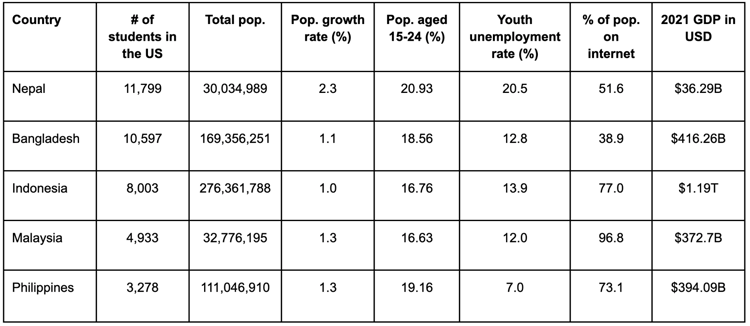
Emerging markets are the talk of the town in the world of international student recruitment. Diversifying enrollment takes many forms. Looking beyond the traditional global student sources has become a valuable exercise.
Last week we took a look at South Korea, Vietnam, Taiwan, and Japan (part 1). This week we turn to Nepal, Bangladesh, Indonesia, Malaysia, and the Philippines.
We are looking at the 3 key indicators that act as a first level screening to see if they point toward student sources worth deeper evaluation: a rising youth population, rising incomes, and employment opportunities for returning students.
Heading To NAFSA 2023: Our presentation with SIO Paulo Zagalo-Melo (Western Michigan University) and Reporter Karin Fischer (Chronicle of Higher Ed) will be on Wed. May 31 at 9:30am. A reality check with the data that informs our student recruitment decisions. Hope you'll join us. Be in touch to meet with us during Nafsa: info@intead.com.
While the countries we are reviewing below will never match the overall outbound student volume of China or India, most institutions are not seeking thousands or even hundreds from a single source. Most universities would do well to gain 10, 20, 50 new students a year from a single new source country. With the right recruitment initiatives, each of these countries could produce these kinds of enrollment results. It requires a multi-year commitment, but you knew that.
The benefits of these diversification efforts:
- You aren’t relying on the top one or two markets.
- You are building a vibrant, diverse student experience at your institution.
- You are recruiting from countries that can most benefit from the programs and experience your institution offers.
And, as you also may know, the markets we cover in this post do come with a bit of risk. Their economies are strong enough, but the cost of international education can be out of reach for many of their families. We know international students are highly motivated to find steady work – so career connections are going to be as important as your academic chops. With any new market entry (Intead advice on that here), there are important analyses that must be done to confirm the opportunities outweigh the risks.
We’d welcome a larger conversation about how these Asian countries may or may not fit into your overall international student recruitment strategy.
Read on for a helpful overview and our usual helpful insights about these markets to support your deeper evaluation.
Here's some quick data facts about the Asian countries we will be talking about:
 * Sources: Institute of International Education, World Bank, IndexMundi, DataReportal
* Sources: Institute of International Education, World Bank, IndexMundi, DataReportal
Nepal
Nepal has made significant strides in education. Per UNICEF, the net enrollment rate in primary schools has risen to 97%, though analysts see significant needs in improving the quality of instruction and equity in access. Only half of students in grades 3, 5, and 8 meet the academic achievement criteria for Nepali language skills and mathematics.
Still, there are those eager and ready to achieve higher education. Of those, many are looking abroad for quality education and an opportunity to work part-time while in school. While most Nepalese students go to Australia, Japan, or India, nearly 12,000 came to study in the US in 2021/22, which was up 5.6% from the year prior and up 32% from a decade ago. Clearly, rising interest in study abroad and the US.
A fair unemployment rate (peaking at 6.9% in 2020), there are many job seeking candidates here. A well-developed manufacturing sector provides a range of business career growth opportunities. Among youth, the unemployment rate is higher giving candidates with standout resumes a boost.
Nepal economic data:
- Rising industries include: airport and ground support equipment, aircraft and parts, medical equipment and pharmaceuticals, water resources equipment and services, renewable energy equipment, telecommunications equipment and services, franchising, and agriculture sector.
- Employment opportunities: JobsNepal
Bangladesh
As reported by the World Bank, Bangladesh is a remarkable story of poverty reduction and development. In 1971, when Bangladesh was established as an independent state, it was one of the world’s poorest nations. In 2015 it reached lower-middle income status and is now on track to graduate from the UN’s Least Developed Countries list in 2026. Poverty has declined as human development outcomes have risen.
In 2021/22, Bangladesh sent 23% more students to study in the US than prior to the pandemic. While there are a number of universities in Bangladesh, only four make the top 1,000 in QS World University Rankings 2023 prompting increased demand for quality education outside the country. The majority of Bangladeshi students currently in the US are seeking graduate degrees though we see opportunities to promote undergraduate programs as well. Note: UK, Canada, and the UAE currently best the US in yielding Bangladeshi students.
A consistently fair unemployment rate (at or below 5% for years and continued through the pandemic), there are many jobs seeking candidates here. A well-developed manufacturing sector provides a range of business career growth opportunities. Among youth, the unemployment rate is higher giving candidates with standout resumes a boost.
Bangladesh economic data:
- Rising industries include: power and energy, agriculture sector, information and communications technology, infrastructure development and engineering services, textiles and apparel, defense/security equipment and services, education, ecommerce, and healthcare and pharmaceuticals.
- Employment opportunities: BDJobs
Indonesia
Indonesia, the world’s fourth most populous nation, boasts the largest economy in Southeast Asia. Between 1999 and 2019 the country cut its poverty rate by more than half to under 10%, though this stat is pre-pandemic. Now the country has assumed the G20 Presidency, encouraging global collaboration to achieve sustainable recovery from the impacts of the pandemic.
Indonesia is particularly susceptible to the nearer-term effects of climate change and must harness its vast natural resources including tropical rainforest, tropical peatlands, and mangrove forests to help mitigate climate change impacts and support the country’s long-term development.
Education is considered of high importance in Indonesia with many families setting aside money for their children’s education even during economic downturns. In 2021/22, 8,003 Indonesian students studied in the US – 4,614 pursuing undergraduate degrees, 1,413 pursuing graduate-level degrees, 150 non-degrees, and 1,312 were OPT. The interest in US education has been steady, neither growing or shrinking, in recent years.
A consistently fair unemployment rate (below 4.3% for years and continued through the pandemic), there are many jobs seeking candidates here. A well-developed manufacturing sector provides a range of business career growth opportunities. Among youth, the unemployment rate is higher giving candidates with standout resumes a boost.
Indonesia economic data:
- Rising industries include: information and telecommunications technology, aviation, energy, financial services, franchising, healthcare, agriculture, education and training.
- Employment opportunities: JobStreet
Malaysia
It’s expected that Malaysia, with one of the world’s most open economies, will transition from an upper-middle economy to a high-income economy as soon as 2024. Yet, according to the World Bank’s Human Capital Index, Malaysia still needs to advance further in education among other key areas to fully realize its aspiration of joining the list of “developed” countries.
Malaysian higher education institutions are relatively new as many were founded in the late 20th century. Still, several Malaysian universities are listed among QS World University Rankings 2023, including #70 Universiti Malaya, #123 Universiti Putra Malaysia, and #129 Universiti Kebangsaan Malaysia.
In 2021/22, Malaysia sent 4,933 students to study in the US, placing the country at #28 among all sending countries. Institutions will find less competition from other universities here. For those making a sustained commitment to building in-country relationships, there will be opportunities. With English being a primary language in Malaysia, many students are ready for foreign study options.
A consistently low unemployment rate (peaking at 4. 5% during the pandemic), there are many jobs seeking candidates here. A well-developed manufacturing sector provides a range of business career growth opportunities. Among youth, the unemployment rate is higher giving candidates with standout resumes a boost.
Malaysia economic data:
- Rising industries include: agriculture sector, education and training, equipment and machinery, aerospace and defense, healthcare, information and communication technology, and renewable energy.
- Employment opportunities: JobStreet
Philippines
The Philippines has one of the fastest growing economies in Southeast Asia and is the 31st largest in the world per nominal GDP. The economy is primarily driven by the service sector, which accounts for roughly 60% of the country’s financial output. Notably, millions of Filipinos also work abroad to send money back to their families each year.
Overall, the education system is considered good and is modeled after the American system. Four Filipino universities rank in the top 1,000 QS World University Rankings 2023 – the top-performing ranking at #412 University of the Philippines.
As one of the countries in Asia where English is the dominant language, many Filipinos aspire to study abroad, though it can be difficult to afford. Still, about 80,000 Filipinos go abroad for higher ed each year according to the Commission on Higher Education, with Canada and Australia garnering the most yield. 3,278 came to the US to study in 2021/22, which is on par with recent years.
A consistently low unemployment rate (below 3% for years and continued through the pandemic), there are many jobs seeking candidates here. A well-developed manufacturing sector provides a range of business career growth opportunities. Among youth, the unemployment rate is higher giving candidates with standout resumes a boost.
Philippines economic data:
- Rising industries include: information and communications technology, defense, energy, transport infrastructure, healthcare, agriculture sectors, and education and training.
- Employment opportunities: JobStreet
What’s next?
Between this week’s post and last, we’ve given you a lot of data to digest. If you are thinking about a deeper, more customized analysis of Asia and whether your institution can become more desirable to students there, send us an email. We’d welcome the chance to apply our deeper market research skills to identify the regions and countries that have the most value to your institution.
We can help steer you through meaningful data that will best pinpoint your most promising markets, big and small.



